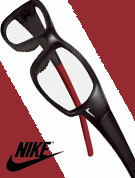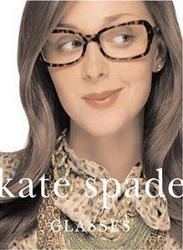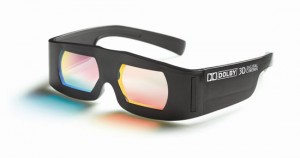Blog
Back to School in 3D
If your child has not been enjoying the 3D summer movies, he or she may have a vision problem.
The 3Ds of Stereoscopic 3D viewing
- Discomfort: Since 3D viewing is based on the eyes converging in front of or beyond the screen, viewing 3D images can potentially create eyestrain and headaches.
- Dizziness: 3D technology can exaggerate visual motion hypersensitivity, which can cause motion sickness, and vergence-accommodation conflict, causing viewers to feel dizzy or nauseous during or after watching 3D movies.
- Lack of Depth: A viewer lacking binocular vision, simply won’t see 3D. While this doesn’t pose any problem viewing the screen, it serves as a “vision screening” that something is abnormal with the viewer’s binocular vision.
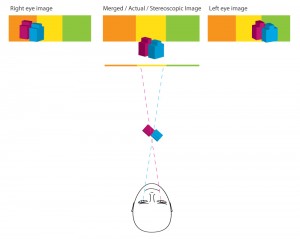 Symptoms indicating a potential problem viewing images in 3D can vary. Some common symptoms include headaches, blurred vision, nausea and dizziness. If you or your child have had an uncomfortable experience watching a movie in 3D, call Westside Optometry for an eye examination.
Symptoms indicating a potential problem viewing images in 3D can vary. Some common symptoms include headaches, blurred vision, nausea and dizziness. If you or your child have had an uncomfortable experience watching a movie in 3D, call Westside Optometry for an eye examination.
Diabetic Retinopathy
In the previous blog post I wrote about the reasons I dilate patient’s eyes. If you have diabetes, I will dilate your eyes at least once a year. Diabetes can affect many organs of the body, in the eyes it causes blindness.
Many problems develop in the retina due to diabetes. There is abnormal blood vessel growth, hemorrhages and lipid leakage. If these problems are allowed to continue without treatment they will cause scarring which leads to detachment of the retina. Another complication is the leakage of fluid under the macula which will severely reduce vision.
Not all these conditions will have symptoms. Only when the bleeding or fluids reach a certain size will you notice blur or dark spots. The earlier changes in the retina are detected, the better treatment results will be.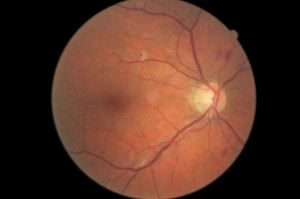
The picture above shows some of the changes diabetes causes in the retina. There is bleeding and some areas where blood isn’t flowing properly (ischemia). This patient did not notice any changes in his vision.
Why do I Dilate the Eyes?
I dilate most everybody’s eyes during an eye examination. If you have any health conditions such as diabetes, are taking certain medication, or have cataracts I will dilate your eyes more often.
Through a dilated pupil I can see more eye structures. I will use diagnostic lights and lenses that provide a 3 dimensional view of the inside of the eye. If there is a retinal hole, a lesion or fluid, it is much easier to detect through a dilated pupil. If I look through a keyhole, I can see part of the room, if I open the door, I can see everything.
Dilation requires drops in the eye. The effect usually lasts 3-4 hours. Most people notice an increased sensitivity to lights because the pupil is larger. I recommend bringing sunglasses to your appointment. If you think driving may be a problem, arrange for a driver. The drops can also cause a cycloplegic effect, which means focusing on objects up close will be difficult. Try to plan your schedule accordingly. Don’t plan on doing computer work or other close tasks immediately after being dilated.
This is the view of a normal retina looking through a dilated pupil. The optic nerve is the whitish circle on the left, it provides an entrance point to the eye for the blood vessels and an exit pathway for the nerve fibers carrying input to the brain. The 130 million photoreceptors (rods and cones) covering the retina, which appears as an orange background, receive all visual images and send these signals to the brain where the vision process occurs. When you have your eyes dilated at Westside Optometry we will take a similar picture of your eye. Don’t let me forget to show it to you.
Where’s that Contact Lens?
Most contact lens wearers have lost a lens. Many lose the lens in the eye while applying or removing it. In most cases, the lens usually falls out, but due to frantic searching in the eye, rinsing the eye, having others poke around in the eye, it will feel like a lens is in there. Why? All that irritation can cause an abrasion, swelling and tenderness. The lens is usually gone, but the eye feels like something is still there. My best advice to you is STOP! Leave the eye alone, a lens in the eye or part of a contact lens in the eye will cause minor to no damage compared to poking and probing in an attempt to locate it. If the foreign body sensation does not lessen or go away in an hour, call my office, Westside Optometry (707)762-8643. With the aid of a biomicroscope and some dye I can easily locate and remove a wayward lens. If it is not still in the eye, I can determine the cause of the irritation and help to relieve it.
Firework Safety
 For most of us, celebrating the Fourth of July means barbeques and fireworks. Unfortunately, the fun can be cut short when fireworks are used inappropriately and cause serious injuries. One of the most common causes of firework injury is when a device explodes before expected. This often results in cuts, burns and bruises in and around the eye. Sparklers are not exempt, in fact they are responsible for a significant percentage of eye injury cases.
For most of us, celebrating the Fourth of July means barbeques and fireworks. Unfortunately, the fun can be cut short when fireworks are used inappropriately and cause serious injuries. One of the most common causes of firework injury is when a device explodes before expected. This often results in cuts, burns and bruises in and around the eye. Sparklers are not exempt, in fact they are responsible for a significant percentage of eye injury cases.
According to a study by the US Consumer Product Safety Commission, fireworks were the culprit for an estimated 8,800 injuries treated in US emergencies departments during 2009. Of these, 54 present were children and teens under the age of 20 years.
Below are tips to help protect and preserve eyesight during the Fourth of July holiday.
- Discuss firework safety with children and teens prior to the Fourth of July holiday.
- Do not allow kids to handle fireworks and never leave them unsupervised near fireworks.
- Wear protective eyewear when lighting and handling fireworks of any kind.
- Store fireworks, matches and lighters in a secure place where children won’t find them.
- Refrain from purchasing sparklers. Heating up to 1,800 degrees, sparklers are the number one cause of fireworks injuries requiring trips to the emergency room.
- Be aware of your surroundings and only light fireworks when family, friends and children are at a safe distance.
Have a happy and safe holiday!
Helping Others with Vision Loss
If you or a loved one is living with vision loss, make living easier. Here are a few tips from the Lighthouse for the Blind Foundation.
- Appliances Mark frequently used settings on appliances with bright nail polish or Touch-Dots.
- Storage Store similar foods together; differentiate like-shaped containers with tactile markings like rubber bands.
- Label Clearly label toxic substances and keep them away from food.
- Clothing Arrange clothing by outfits, color, or with large-print labels.
- Pills Use large-print or color-coded labels, or buy pill organizers and talking pill bottles.
- Rugs Remove throw rugs or use non-skid rubber backing or double-sided tape to eliminate sliding. Always use non-skid rubber mats in the bath.
- Talking Aids Purchase talking appliances like watches, weight scales, and alarm clocks.
- Lighting Use flexible-arm lamps to focus light on the task, Install under-cabinet lighting in your kitchen, and use nightlights in hallways and bathrooms.
Ultraviolet Protection
Ultraviolet light from the sun will burn you skin, it will also damage your eyes. A sunburn on the cornea, the surface of the eye is called, “photokeratitis”. The incidence of photokeratitis increases when in the snow or on the water because of increased reflections. Most of us know the pain of a sunburn on our skin, a sunburn on the eye hurts much worse and causes the vision to be blurry until it heals.
Other eye tissues are permanently damaged by ultraviolet(UV) light. The conjunctiva, the white of the eye can develop benign bumps called pinguecula. Pinguecula are not dangerous, but they can become inflamed and red. They typically have a yellowish appearance. Cataracts, (a clouding of the lens in the eye) worsens with UV light exposure. The retina is also susceptible to UV damage. Damaged retinal tissue, especially the macula can lead to severely reduced vision.
Sunscreen protects your skin from overexposure to the UV rays, sunglasses protect the structures of your eyes and the skin tissues around them. Read how to select quality sunglasses in an earlier blog.
Presbyopia
Have you ever been in a restaurant trying to decide what to order? The lights are dim, you are practically burning up the menu manipulating it around the candle for more light… Or how about trying to hook up wires behind the TV or computer, can’t find the right hook-up? The above situations make presbyopia seem like an acute condition. Things that looked OK at the kitchen table by the window don’t seem as clear in the dark or when you are tired.
Presbyopia is the result of an aging process on the lens of the eye. The lens focuses light at all distances without much effort for the first forty plus years of our lives. Then kablamo…you can’t see to remove a sliver from your child’s finger.
Denial is the most common response. Eventually, presbyopia interferes with work. You find yourself switching numbers or getting headaches at the computer. Your over-all efficiency is diminished and your frustration is elevated. Sometimes a pair of reading glasses will solve the problem. Depending on your prescription and how you use your eyes, multifocals offer clear vision at multiple distances. Contact lens wearers can try monovision (an adjustment in the correction of one lens) or bifocal contact lenses.
Just know that you are not in this alone, my presbyopic eyes and I are here ready to help you. Stop struggling and let’s find a solution.
Age-Related Macular Degeneration
I attended a seminar this weekend titled, “Can we do better in AMD?” AMD is age-related macular degeneration, the leading cause of blindness worldwide. The current number of individuals with visual impairment from AMD is 620,000. The forecast for 2050 is more than double, 1.6 million.
Who gets AMD?
The Elderly (hence the “age-related”)
Women more than men
People with light colored eyes and hair
These are the conditions we can’t control, but we can control the following:
Smoking. This is a huge factor. In fact, smoking will double your risk of developing AMD
Exposure to ultraviolet radiation. Put on those sunglasses
Diet – increase fat intake increases the risk for AMD
There are lots of studies about prevention of AMD and treatment. By the end of 2010 genetic testing will be available to determine a person’s risk for developing AMD. The test involves swabbing the inside of the cheek to collect tissue for analysis. This will be helpful in determining vitamin therapy, examination frequency and peace of mind for those determined to have a low risk. Stay tuned for details in the months to come.
At your next eye examination ask me about vitamins and supplements that are recommended for regeneration of retinal health.
